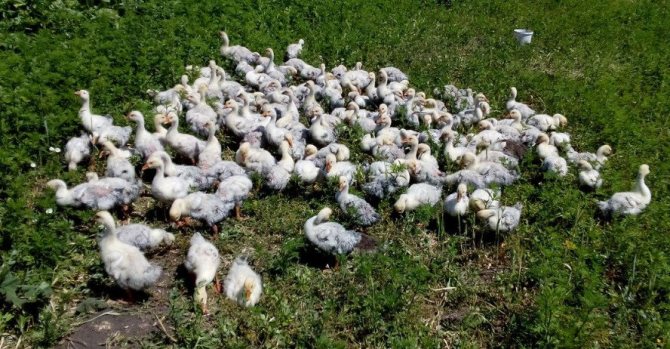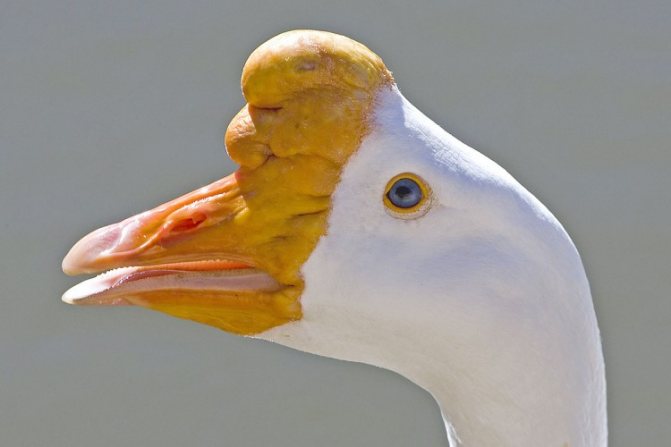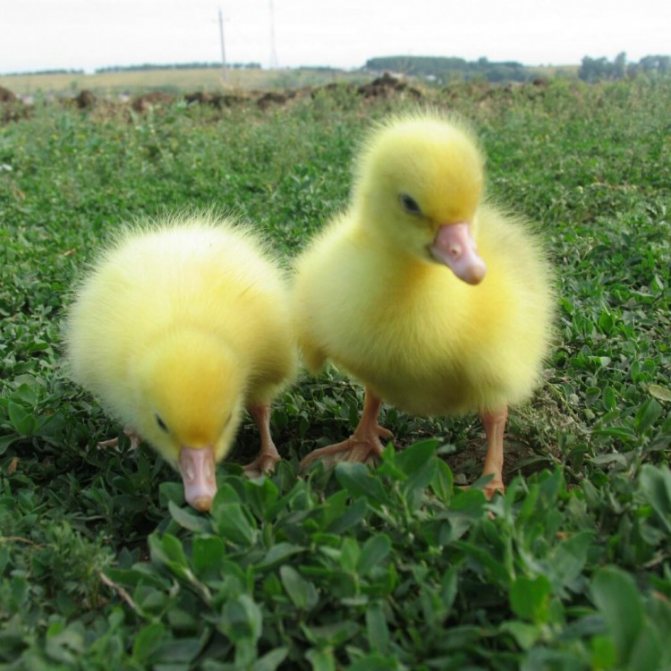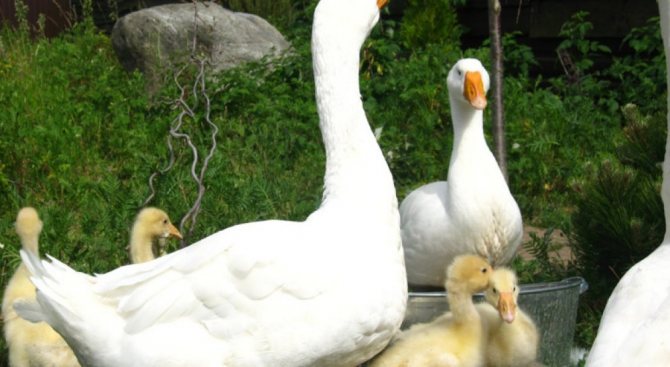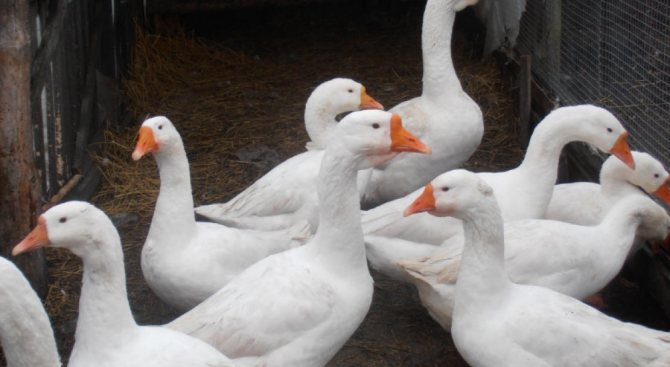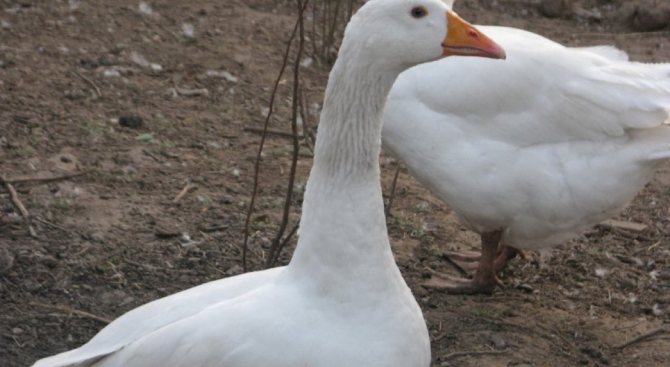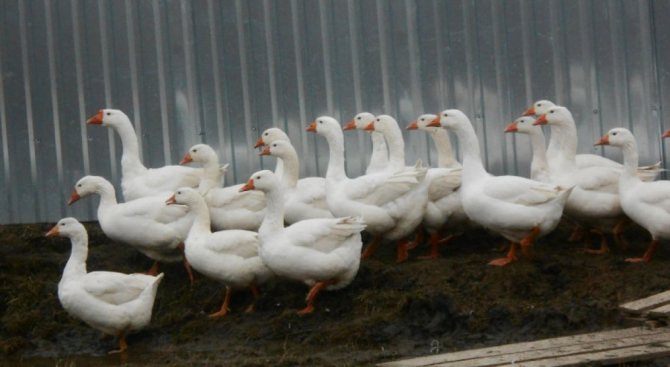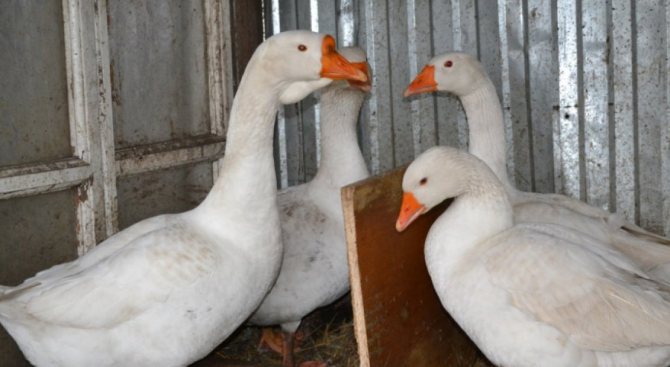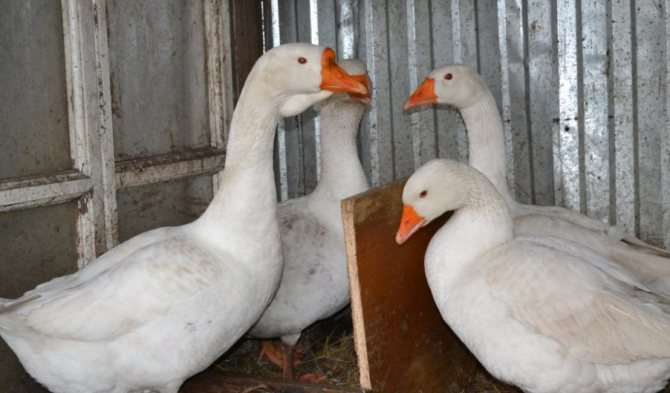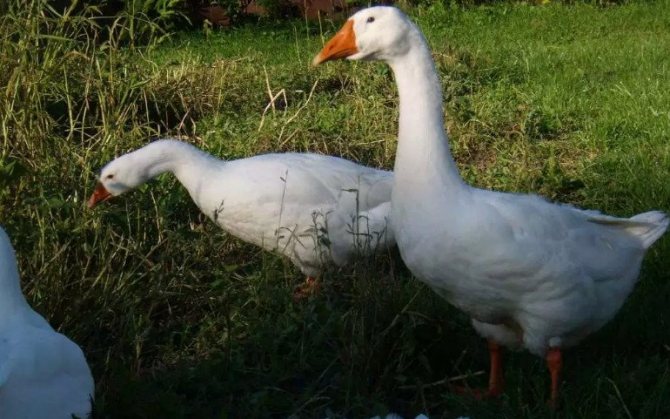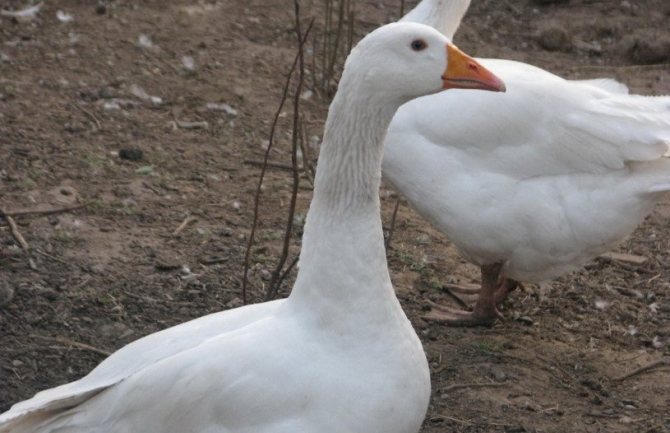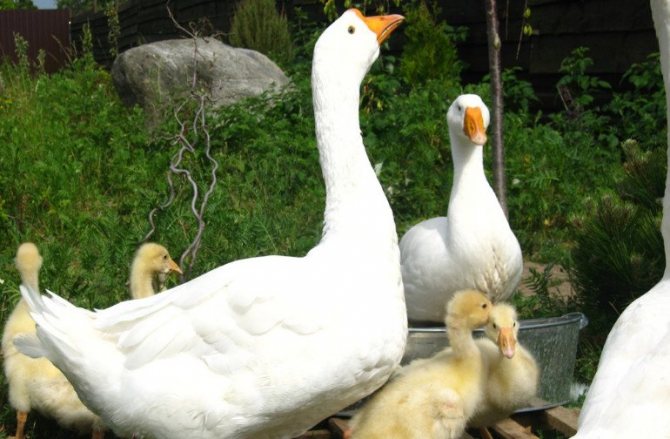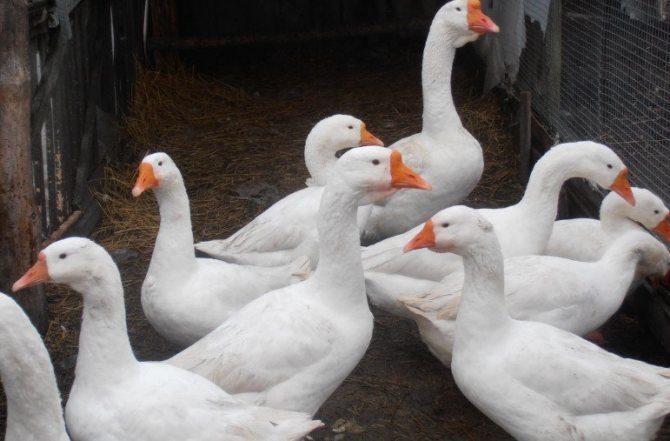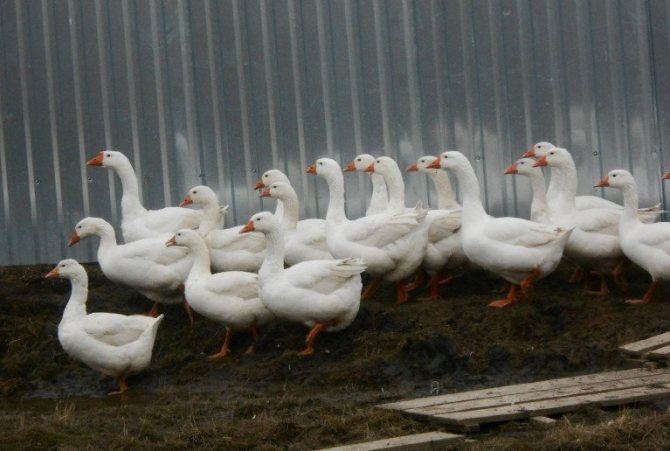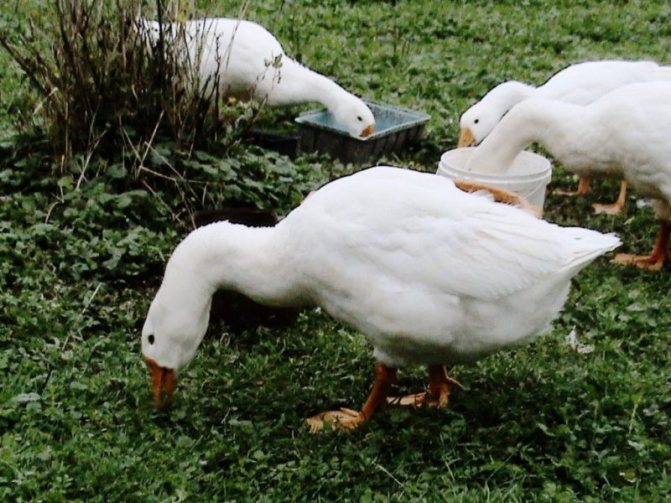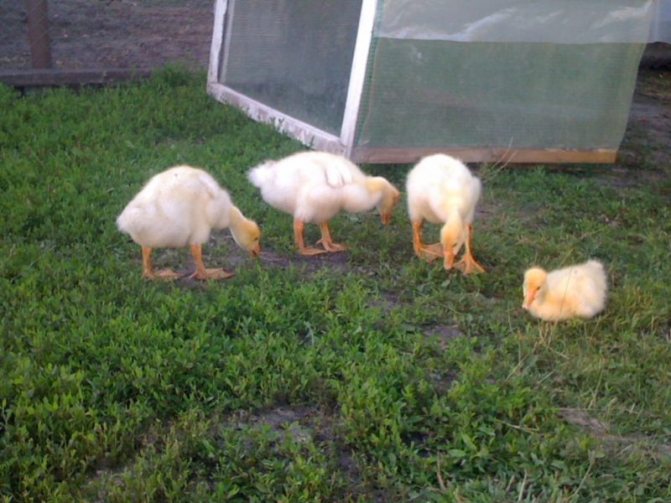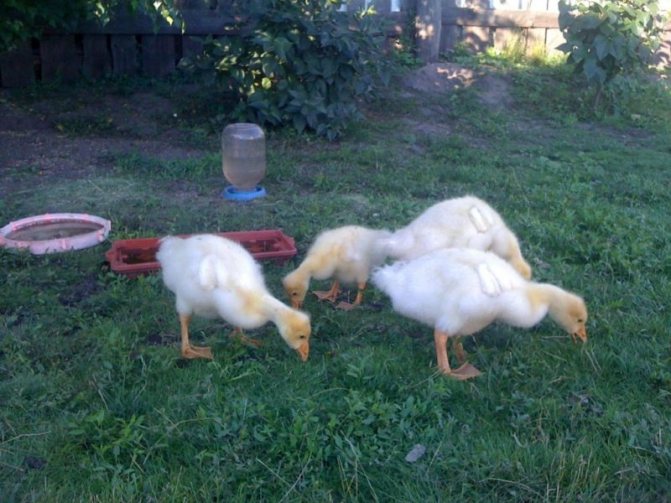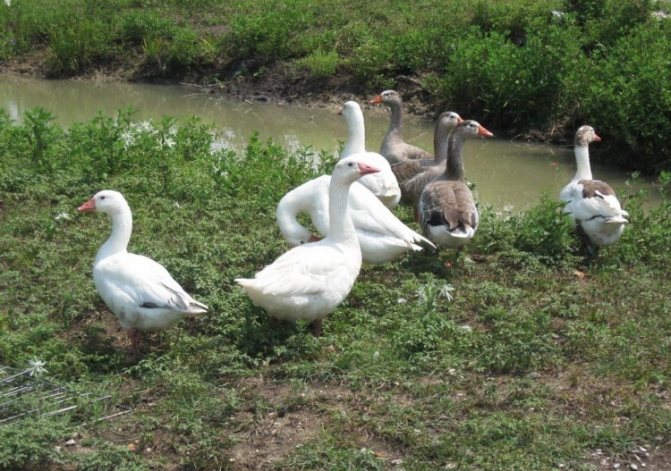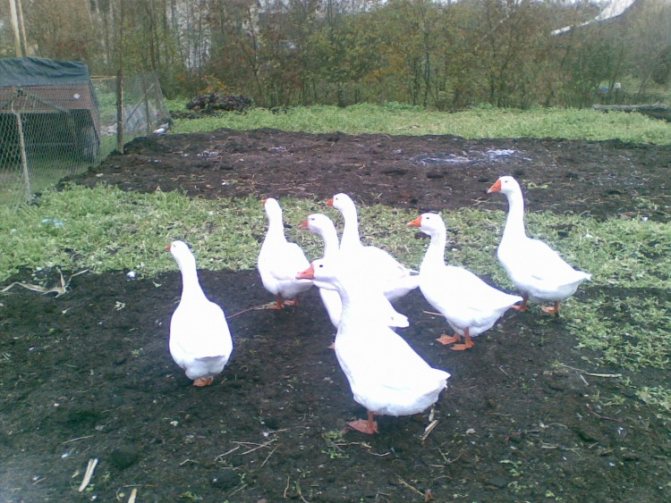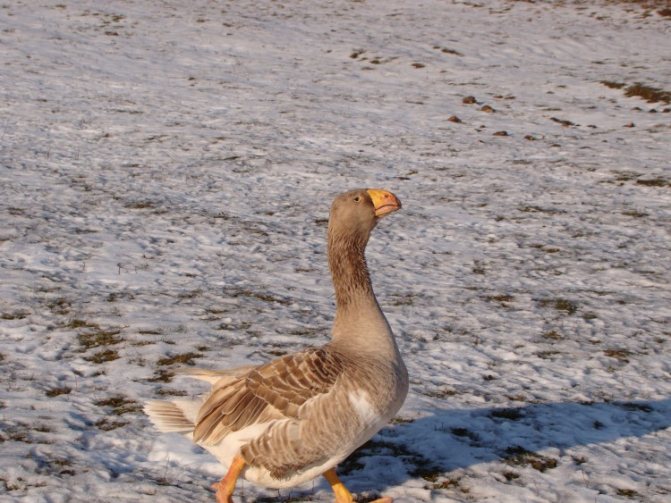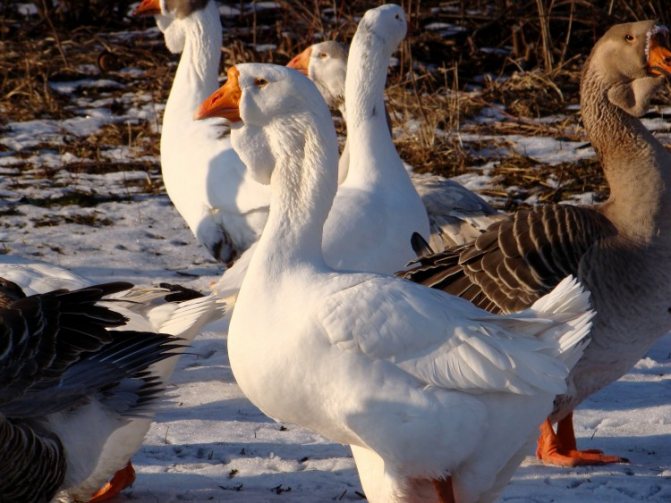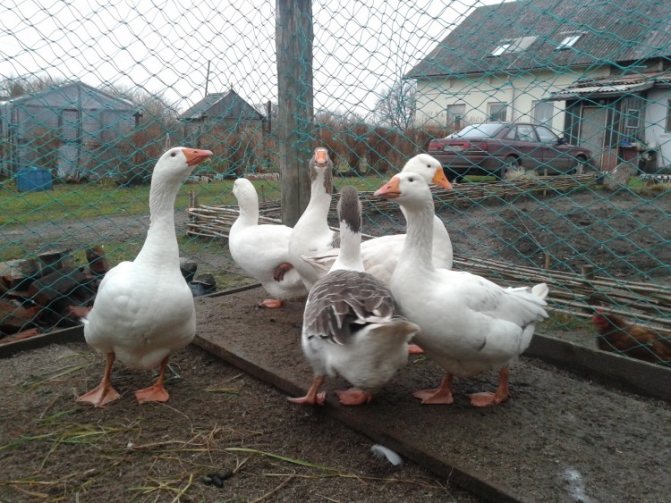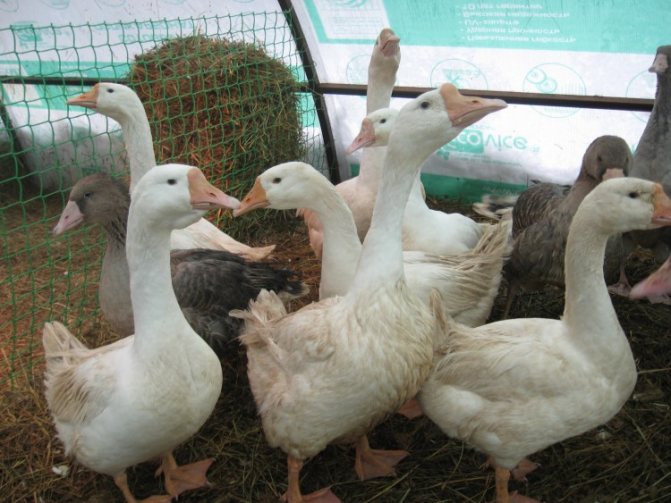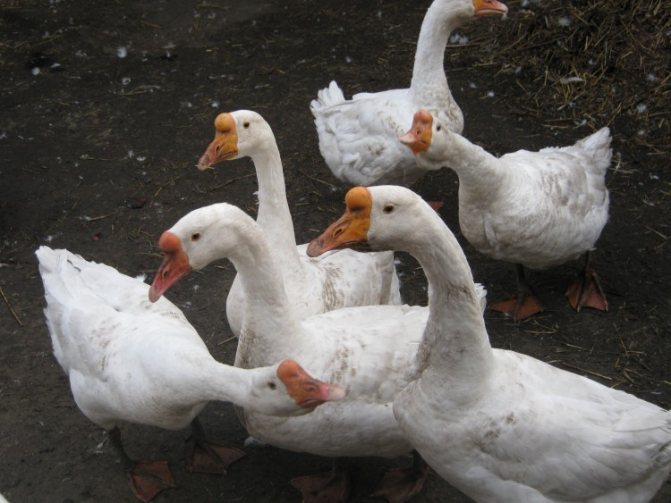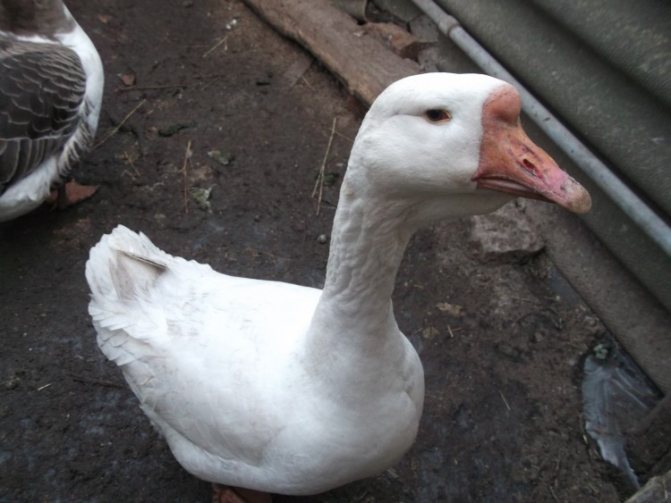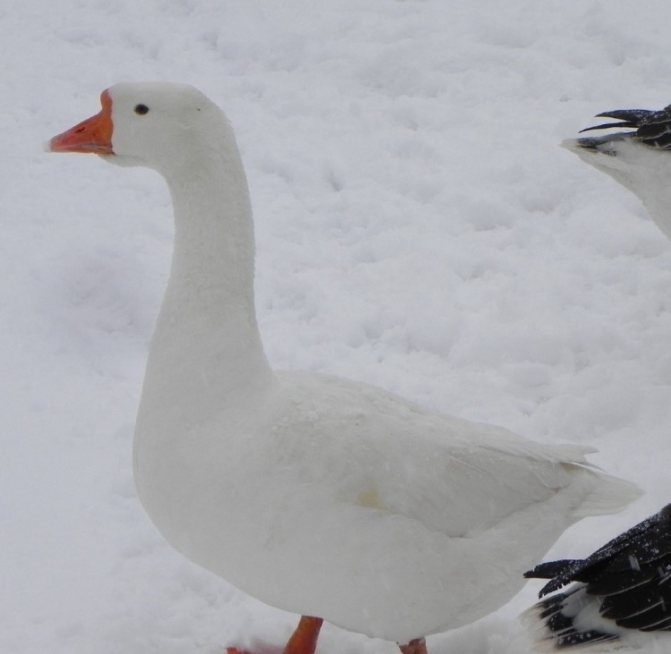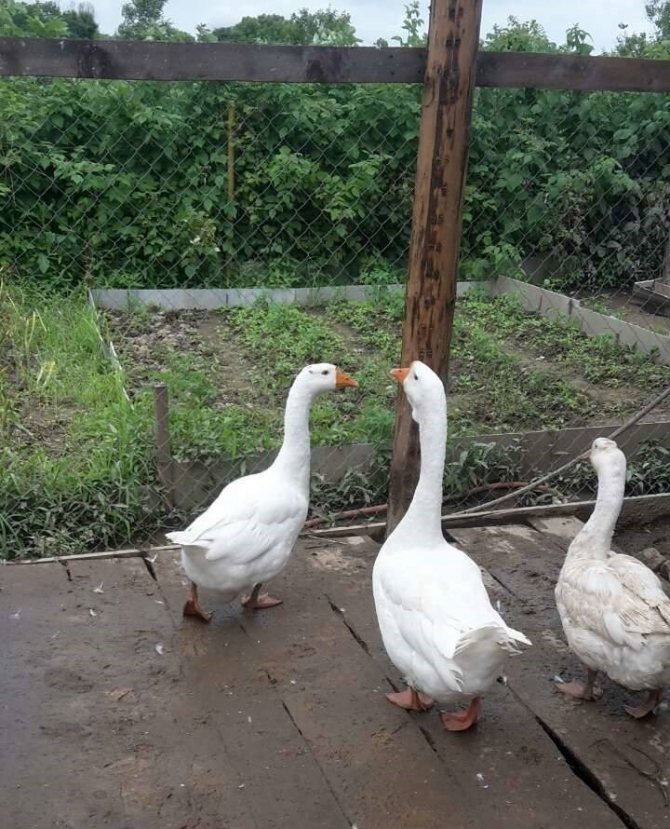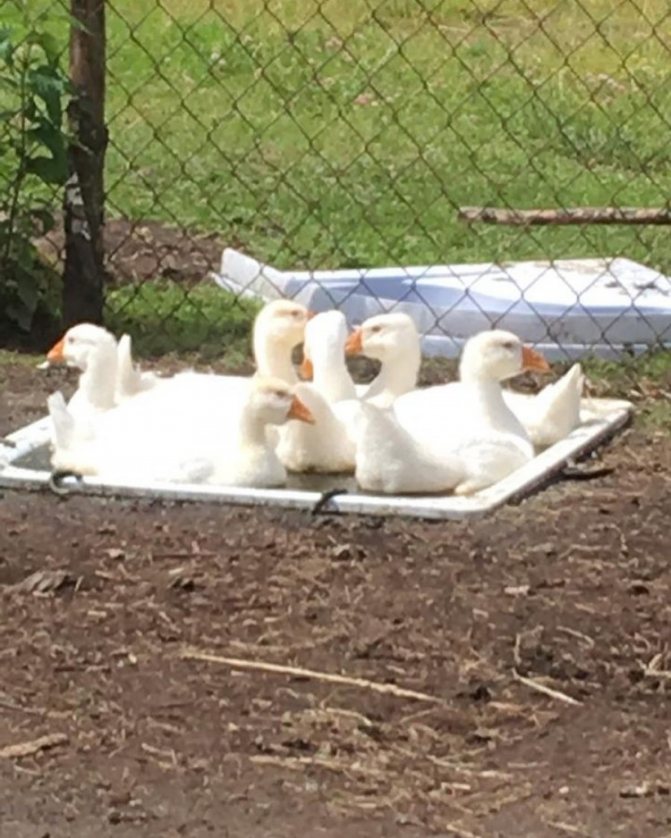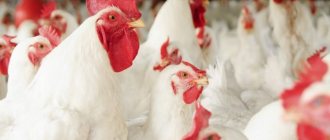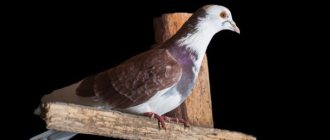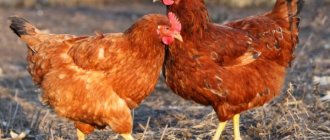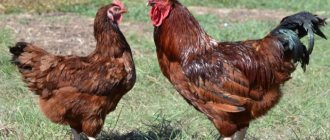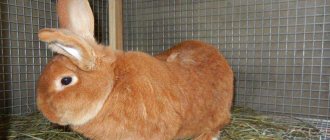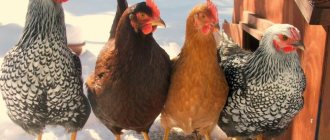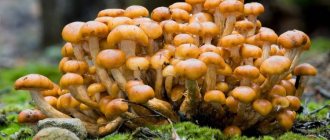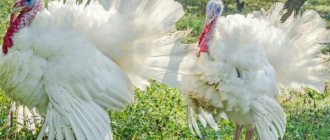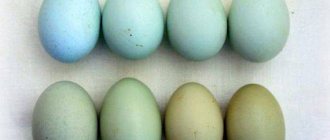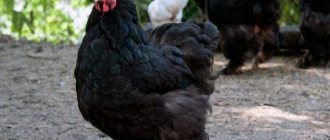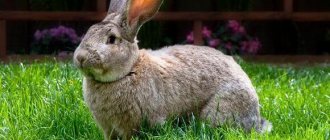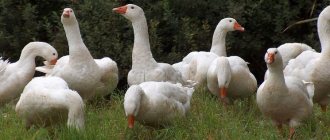Poultry »Geese
0
1768
Article rating
Geese Linda is one of the most widespread breeds in our country. They have snow-white plumage with beige tan marks. Rarely, gray specks may appear on the back and in the area of the wings, this is considered the norm.
Geese Linda
Description of the breed
The body of Lindovsky geese is large, elongated, scaphoid. The plumage is white, the fluff grows seasonally, very thick, you can collect from one goose up to 140 g of downy raw materials... On the beak there is a peculiar bulge ("bump") left over from the Chinese cone-nosed geese.
The color of the legs and beak varies within different shades of orange.
There are two lines in the breed, they differ in egg production and live weight.
Line No. 1 belongs to the meat type, birds of this line have a live weight of 4-4.5 kg in 60-70 days, adult birds weigh up to 8 kg and sometimes even more.
Line No. 2 characterized by birds of a more delicate structure, and deviates towards downy and egg production. This is how the geese of this line begin to lay at an age 8-12 months and in the first year they give up to 50 eggs, with a subsequent increase in productivity.
At the same time, the mass of eggs in pullet geese is about 100 g, and full-grown layers give eggs up to 160 g.
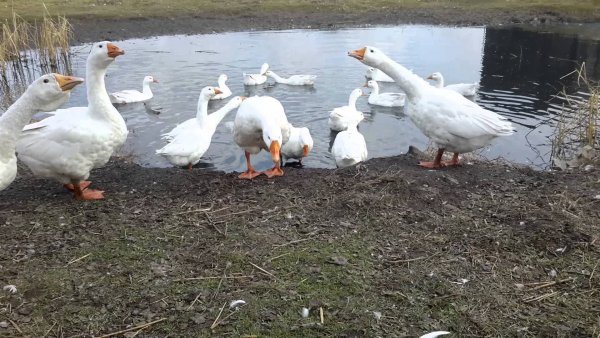
Egg production of a bird
One goose can lay up to 65 eggs per yearthis usually happens in the spring. One egg weighs on average 160 grams. Almost all eggs are fertilized.
In the incubator, up to 80% of the eggs remain viable. Of the hatched chicks, 90% of all cubs survive to maturity. To some extent, this is the merit of the female goose Linda, as she is considered the best brood hen.
For high egg production of the goose requires calcium and green fodder... If these two conditions are met, and the correct lighting is added to this, then it is quite possible to achieve decent performance and provide yourself with eggs both for cooking and for breeding geese of this beautiful breed.
Characteristics, advantages and disadvantages of the breed
| Dignity | disadvantages |
| Rapid weight gain | Access to a reservoir is desirable |
| High palatability of meat | Susceptibility to vitamin deficiency |
| Resistance to external factors | Noisy gaggle |
| Relatively high egg production | |
| Low chick mortality | |
| High hatching rate | |
| Almost omnivorous | |
| Peaceful character |
The most important characteristic of Linda geese is their rapid growth, the daily weight gain of goslings on full-feed compound feed reaches up to 100 grams per day.
Accordingly, for 1 kg of the product obtained, the lowest feed costs are about 4 kg of concentrates (grain, compound feed) and 7 kg juicy(grass, vegetables, table scraps).
Despite their large weight, Linda geese are mobile, love to run and fly, ganders are active and pugnacious, jealously guarding their females from other people's encroachments.
Thanks to this temperament fertility of eggs 93%, the yield after incubation is also high - 85-90%... However, it must be remembered that a bird can show all its good qualities only under the right conditions of keeping and proper feeding. The meat qualities of the breed are kept at a high level.The carcass has an even distribution of fat not only under the skin, but also between the muscles of the sternum. This gives the meat a special juiciness, the protein content in the carcass is 21%, fat is 6-8%.
At the same time, the palatability of their meat remains record high even when frozen for a long time, which makes this breed ideal for sale.
From the Lands breed, the Linda got another feature, they can be fattened by special diet for fatty liver, from which the world famous delicacy is then prepared - foie gras.
Geese for three to four weeks of fattening give 400 g such a product, and as a supplement it turns out to be an excellent carcass 4-5 kg for baking or smoking. Linda, like other breeds of geese, are resistant to cold, they received this feature from their wild ancestors.
Many breeds participated in the development of linda, this gave a wide variety of genetic variations. That is why the goslings have such a high survival rate - 90%, congenital genetic abnormalities are almost never found in Linda geese.
The disadvantages of the breed include almost completely suppressed incubation instinct... Geese rarely sit on eggs, many abandon their clutch after several days of incubation. Sometimes it happens that too heavy a female pushes the eggshell with her claws.
Same geese make a lot of noise, males constantly change the hierarchy in the herd, females can also fight, all this is accompanied by a loud cackle and flapping of their wings, if you are going to keep Linda geese in a confined space, this can become a problem.
These birds love water, if you do not have a reservoir nearby, then always make sure there is enough water, after all for 1 kg of food eaten, geese drink 4 liters of waterAlso, water consumption in hot weather may increase.
In winter, they drink less and are satisfied with eating snow while walking, but remember, even in the coldest and snowiest winters, geese should get water at room temperature once a day, then their digestion will not suffer.
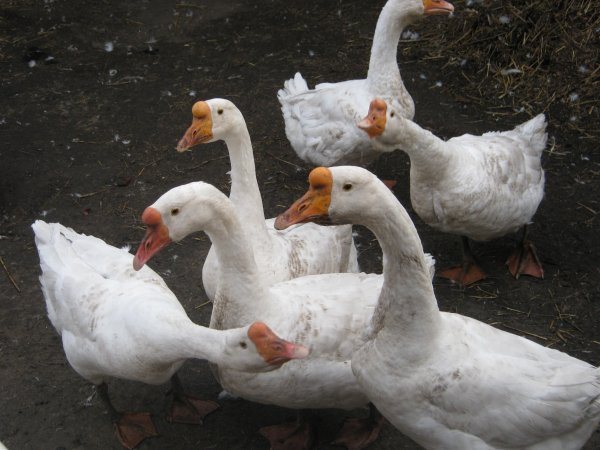

How to care for young animals?
First of all, you need to think about how the room will be illuminated. Up to ten days of age, goslings should have a light on around the clock. Then the lighting time is gradually reduced - from 10 to 20 days it should be at least 16 hours, from 20 to 45 there is another reduction - to 14 hours a day.
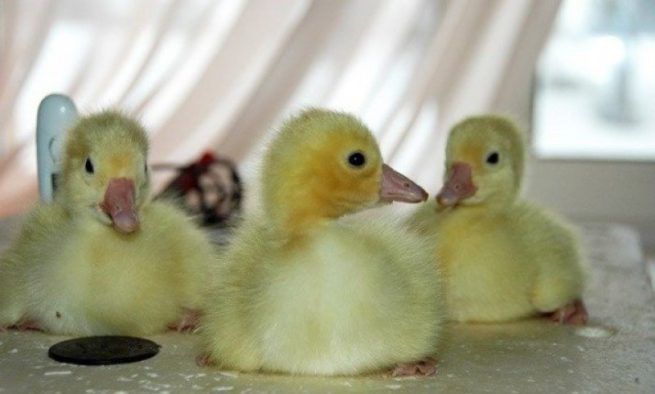

An important stage in the breeding of lindovan geese is the growth time of flight feathers, it falls on 28-49 days. At this time, young animals have an increased susceptibility to irritating factors, these can be unusual sounds, the occurrence of noise. While feeding the goslings, it is recommended not to make sudden movements, to try to make sure that as little extraneous sounds as possible penetrate the room. It is recommended to communicate with young animals as often as possible.
Diet for growing at home
| Feed type | Feed amount (g) depending on egg production during the productive period | The amount of feed (g) in the non-productive period |
| Grain, cereals | 73-140 | 90 |
| Wheat / corn flour | 17-45 | 30 |
| Wheat / rye bran | 50 | 50 |
| Clover / meadow hay | 50-100 | — |
| Meat / fish waste | 4-13 | — |
| Peas / cake | 5-12 | 25 |
| Carrot | 100 | — |
| Sugar beet | 100 | — |
| Chalk / grated shell | 1,5-9,5 | 8 |
| Bone flour | 0,5-3,5 | 3 |
| Salt | 2 | — |
Attention! Linda's chicks are unable to digest large amounts of fat and greens.
In winter and spring, with one-sided incomplete feeding, Linda geese suffer from vitamin deficiency. The sick bird becomes inactive, the feathers are dirty, the eyes watery, the eyelids swell on them. Chicks during intensive growth can develop rickets or joint crusher - a lack of vitamin D3. Let the geese graze in the summer on lush green grass, in the fall and winter, introduce vitamin-herbal flour and grated vegetables, carrots, pumpkin, semi-sugar beets into the feed.Geese, unlike other birds, digest plant fiber very well and take all the necessary nutrients from it.
If you have doubts about the sufficient amount of vitamins in the feed, just buy any oil-based trivitamin (AED3), add a bottle of 100 ml per 1 liter of fish oil and treat your geese with this mixture a couple of times a week, pouring over the morning food in the amount of a table spoon per bird Geese require mineral feed to maintain a healthy balance of calcium and phosphorus. If your bird walks freely in the surroundings or has access to a natural reservoir, you do not need to worry about mineral nutrition. If the bird is intensively fattening or is preparing for laying eggs without getting a walk, you will have to take care of a separate feeder where chalk is mixed with a shell, and adding meat and bone and fish meal to the diet. For good digestion, birds need to swallow small pebbles, which once in the stomach, they will grind plant food.
The nature and mode of nutrition varies at different times of the year.
What to feed in the summer? Mature geese can graze on their own and feed on meadow vegetation, coming home only at night. But in the evening they must be fed with a grain mixture or mixed feed, in the calculation of 120-150 g on the head.
What to feed in winter? At this time, geese are fed a mixture of grain feed, succulent root crops (carrots, potatoes, pumpkin) and grass flour or fine hay dust.
In the morning, a wet mixture is prepared, root crops are rubbed on a coarse grater, you can use cleaning and scraps from the table (which are better to boil) and knead with ground grain, steamed granules of vitamin-herbal flour or hay dust are added to the mixture.
The rate of such a mixture, depending on the age and condition of the bird, can vary, within 30-800 g... Also, for fattening and breeding birds, the ratio of cereals in the composition of the mash varies.
Linda geese grow rapidly, with high cereal levels, breeders can become obese. In the evening, especially if the night is expected to be frosty, you can give not ground grain or mixed feed at the rate of up to 150 grams on the head.
Do not forget that there should always be fresh water or clean snow in the drinkers.
Note! In no case should the diet of geese be drastically changed, as this leads to obesity, or vice versa - to dystrophy.
Linda Geese Standards
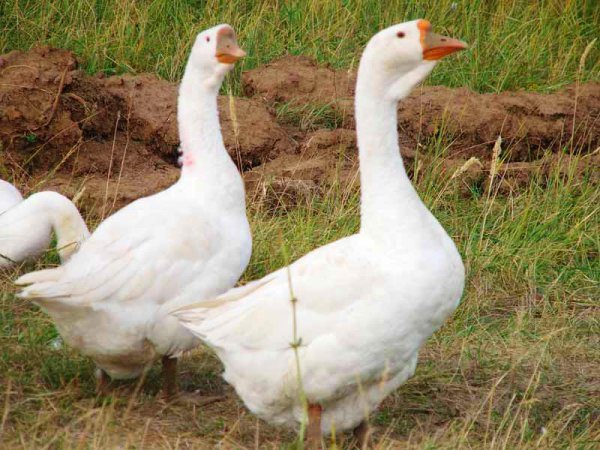

To keep the geese Linda, a poultry house is needed, designed to avoid drafts. The necessary equipment includes nests, feeders and drinkers.
Nests should be placed on the floor in the corner of the house so that - one nest for 3-4 geese.Make a nest out of plywood 40x60x50 cm without a bottom and put it in the chosen place, having previously sprinkled the chips there (it will replace the bottom of the nest).
A warning! Be sure to compare the number of birds with the area of the territory that you have. For a goose to feel comfortable, he needs 1.5 square meters. m of floor and 0.2 sq. stern front at the trough. In close quarters, Linda falls ill, large ganders oppress the geese, as a result of which the former become obese, and the latter suffer from dystrophy.
Productivity
Linda geese are productive birds, which are characterized not only by good egg production, but also by rapid weight gain. As mentioned earlier, young animals weigh approximately 4 kg by 3 months, and from eight months of age, individuals are considered mature.
On average, the weight of one egg varies from 140 to 170 g, and the egg production is about 5 dozen eggs in 365 days. If the geese are given proper care, then you can get 2 dozen more, and this is a clear indicator of excellent productivity. No less high rates in reproduction, about 90% of eggs, as a rule, are fertilized, and during the incubation period 70% of goslings can be hatched.Linda geese have perfectly preserved maternal instinct, they sit perfectly on eggs, and then take care of the offspring, thanks to this, the survival rate of young animals is 90%.
Incubation
If a Your goal is to create conditions for the incubation of eggs, it is important to do everything so that the goose laying eggs does not leave its home.Firstly, make sure that her nest is in a calm and quiet place where no one can disturb her.
Secondly, do not take the very first eggs from the hen (they are most often infertile). you cannot put more than 20, the best option is 15-17 pieces.
Do not interfere with hens leaving the house every day to feed and empty, but do not leave eggs unheated for more than an hour. Be sure to provide the expectant mother with a bathing container, while bathing the goose brings the moisture necessary for eggs on its feathers.
Pecking of eggs occurs for 28-29 days, and then the goslings should hatch at one moment, if it is difficult to exit the eggs, this is a consequence of a violation of the incubation regime. When you find the hatched goslings, it is better to take them from the mother for drying. Place goslings in containers where the air temperature fluctuates between 26 and 28 degrees Celsius.
The goose that hatched them will take care of the babies as soon as all the chicks hatch from its eggs. However, at the first infusion, observe how the mother behaves, whether she is caring.
A good mother warms the chicks, letting them under her wings, finds food, pointing at him with her beak, in every possible way protects the offspring in case of encroachments on him.
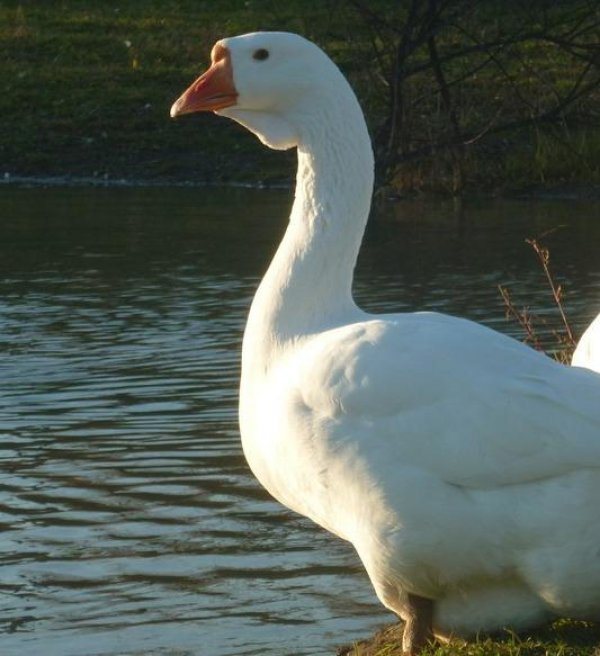

Breeding features
The Linda goose begins to lay its first eggs in February. They cannot be taken away from the bird, otherwise it will leave the nest. In the future, the eggs are selected and the date of laying is marked on them. Store them at a temperature of 5-12 ° C, turning over every 12 hours. If the goose does not leave the nest for several days, you can put 11-15 prepared eggs under it. During incubation, the bird leaves the nest daily for 15–20 minutes. If during this time the goose has not returned, you must transfer it to the nest yourself.
Important! Until all the vaccinations are made, no one is allowed to the young animals except the mother.
From the 16th day of incubation, the eggs are periodically sprayed with water when the bird goes out for a walk. Goslings begin to hatch on day 30. They are allowed to dry a little under the mother, and then the umbilical cords are cauterized to prevent the spread of the infection. Goslings are taken from their mother for a day and kept in a dry spacious box at a temperature of 28 ° C. After 24 hours, they are admitted to the mother and kept in a closed room, observing the supplementary lighting scheme.
